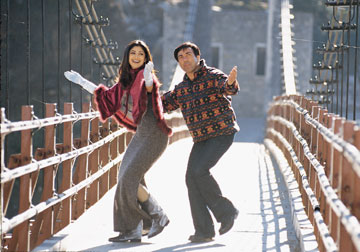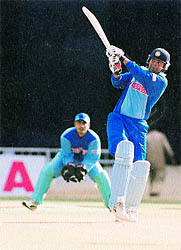Screen Play
Writing
K.Ramanathan
CHAPTER
6
THE VISUALS
The
most popular and most effective audio visual medium is no doubt the film. One
may argue that TV is viewed more often than a film and so should be classified
as the most effective of the media. But
the truth is that while one watches TV, it is likely that his attention may be
distracted , while the film, viewed in a darkened cinema hall, has the viewers
so engrossed that it has far better impact on the viewers than any other medium,
including the TV. The reason why a
reference to this is made here, in a course on screen play writing is that while
writing for such an effective audio visual medium, the writer
has to think of how, what he has written will be presented by the
director and how it will be perceived by the viewer. It is important to
remember that it is the director, who is in charge of transforming the screen
play into a film and he will think in terms of both the audio and the visuals,
that he can use, even as he reads the screen play. If the writer also thinks in
that way, it will be easy for the director to appreciate the screen play.
A screen play writer, who is director friendly, is sure to be successful
As
said earlier film, can be loosely defined as a compilation of shots, of course
padded with visual and audio effects, apart from the acting and the dialogue
that will be spoken by the artists. Obviously
the dialogues are to be written by the screen play writer and while doing so he
must remember what will be the shot in which the artist will deliver the
dialogue. This of course is not a necessity, but definitely an
advantage for a good screen play writer, as it will make the job of a director
and the artist easier.
It
is assumed that you, an aspiring screen play writer would have seen a number of
films and even if you may not be very conversant with all the types of shots
used in a film you will be, surely aware of them, as seen in many films.
The
shots are generally categorised into three distinct groups, known as the
close up, the mid shot and the long shot.
Many of them are known to many people today.
Of course there are other types of shots also, but almost all of them can
be broadly classified into one of these categories
The
CLOSE UP
:This can be defined as a shot that reveals a person in close up, but It
also means that the

The
close up is used mostly to emphasise the expression of the artist.
By now you must have formed an idea as to where this shot will be used
and how much of the dialogue is to be spoken by the artist in this shot. Make a note of what you have guessed and check up with what
will be said later, to ascertain whether you are able to ,understand the guide
lines for writing a screen play. You can try to visulaise the shots with
reference to the screen play, that was an example earlier in the chapter.
THE
LONG SHOT : As
the name suggests it will show the scene in a long shot, which could be construed


If
the same shot is shown in a close up of the ball travelling in air, you may not
appreciate it much. If the fielder had caught the ball and the shot is repeated
in a close up, you would enjoy the shot, particularly the action repeated in a
close up.
In
this example you might have felt that while it is true that the long shot
showing the ball going high up on the air when everyone was anxious to know
whether it will be a six or a catch, is enjoyable, the close up of the fielder
catching the ball is not very effective, even though it was a replay or repeat
of the action in a different range of shot.
If
this is what you think, then you are dead right.
Because the action of a fielder taking the catch is not enjoyable in
close up; but then the long shot is also not effective.
So what do we do?. Well we
use something in between and that is
THE
MID SHOT :

By
now it must be clear to you that a mid shot is somewhere between the close up
and the long shot, as far as the content and effectiveness are concerned.
Actually it is wrong to call it as effectiveness, as the effectiveness
depends on what we want to emphasise on. Each
and every shot is effective, when it is used properly and in the right place.
For the time being, it is enough to know the difference between the
shots, as we have seen just now.
THE
OTHER SHOTS
: In addition to
these three types of shots, there are a number of shots that are being used in a
film. Some of them are the Two
shot, over the shoulder shot, zoom shot and tracking shot.
The names are self explanatory, for you to understand what you can
expect in these shots. The two shot will have two characters in the shot, while
in the over the shoulder shot, the camera will be placed behind one
person, whose shoulder will be in the foreground, while the second person will
be facing the camera.
 This is used mainly
when we have two characters sitting opposite to each other and talking. Of
course they can be standing as well. But
the important thing is that they must be facing each other. The advantage of
this shot is that we can alternately show each person direct to the viewers and
at the same time remind them that there is another person sitting in front.
This is used mainly
when we have two characters sitting opposite to each other and talking. Of
course they can be standing as well. But
the important thing is that they must be facing each other. The advantage of
this shot is that we can alternately show each person direct to the viewers and
at the same time remind them that there is another person sitting in front.
As
you can visualise and might have seen in many films, the zoom shot is the one
that will begin as a long shot and go to the close up or vice versa.
The action will be continuous and the shot will not change as such, but
the image size will change continuously. Almost
the same effect can be obtained by the tracking shot, in which the camera will
move towards or away from the character, changing the shot from a long shot to a
close up or vice versa. You may
wonder if the result obtained is the same in both the types of the shots, then
what is the need for two different types of shots.
The result, that you observe is only apparent, as actually there is a
difference in the perspective of
the images in both the shots.
In
the zoom shot there is no change in the perspective ( the one that gives you the
feeling of depth and the third dimension in an otherwise two dimensional
picture) while there is a change in the perspective in a tracking shot.
In other words while the image size changes in both the shots, in the
zoom shot the ratio of the image sizes between the foreground and background
objects remains the same, while in the tracking shot, this ratio also varies
giving you a better feeling of the perspective.
You may then ask why should anyone use a zoom shot at all.
Zoom
shot is generally resorted for two reasons.
One is when it is not possible to lay a track on which the camera is to
be mounted to move it forward or backwards, the zoom shot comes in handy, as it
is only the manipulation of the lens that gives the effect of the zoom.
Another reason is that if the effectiveness of forward or backward
movement has to be very fast, this can be achieved only with the help of the
zoom lens. A tracking shot does
take time as the camera is to be physically moved from point to point.
The
tracking shot is not always a shot with a forward or backward movement of the
camera. The camera can be taken
parallel to the artiste as he walks along and now it can also be a circular
movement of the camera. These are
not possible to be achieved with a zoom lens. (Zoom lens is the one that is
needed for the zoom shot)
In
addition to these shots, explained here, you may hear words like subjective or
point of view shot. This is nothing but a shot taken from the point of view of a
character; that is to say that the camera takes the place of the character in
observing the scene
In
short when we talk of a shot, we actually refer to the size of the image that
will be used in the film. Of course you have to know that in a close up the image
appears to be bigger, while in the long shot it appears to be smaller. All these
words are only comparative and do not have any definite dimension.
It is only for easy reference that the shots are classified as close up,
long shot, and shot etc.
POINTS TO REMEMBER
1.
The main job of the screen play writer is to write the dialogues. But the
director, who is in charge of transforming the screen play into a film will
think in terms of the visuals he can use, even as he reads the screen play.
Therefore it is better for
the screen play writer to think of the possible visuals as he writes the screen
play A successful screen play
writer has to be director friendly.
2.
Film can also be loosely defined as a compilation of shots.
3.
There are a number of types
of shots used in a film. They are
broadly the close up, long shot, mid shot, zoom shot, tracking shot etc.
4.
Classification of the shot is generally based on the composition, that is
the size of the image that will be presented through the shot.
5.
To know the effects of the shots, see films and sports coverage on TV.
|
|